The Economics and Statistics Division maintains archives of previous publications for accountability purposes, but makes no updates to keep these documents current with the latest data revisions from Statistics Canada. As a result, information in older documents may not be accurate. Please exercise caution when referring to older documents. For the latest information and historical data, please contact the individual listed to the right.
<--- Return to Archive
For additional information relating to this article, please contact:
June 24, 2022INDUSTRIAL RESEARCH AND DEVELOPMENT, 2020 (ACTUAL), 2021 (PRELIMINARY) AND 2022 (INTENTIONS) Statistics Canada has recently released Industrial Research and Development (R&D) characteristics, including 2022 intentions, preliminary actuals for 2021 and characteristics of industrial R&D spending/personnel across provinces for 2020. Results from 2014 and beyond are not directly comparable to earlier data.
In 2020, Nova Scotia businesses spent $179 million on research and development, down 10.9% from the previous year. Nova Scotia’s total business enterprise expenditures on R&D accounted for 0.38% of its Gross Domestic Product (GDP) in 2020, down from 0.43% in the previous year.
Nationally, businesses spent $22.6 billion on R&D, an increase of 3.3% over 2019 spending. Canada’s R&D spending accounted for 1.03% of its GDP in 2020, up from 0.95% in the previous year.
Quebec (1.31%), Ontario (1.24%), and British Columbia (1.04%) have the largest share of their economy in research and development expenditures in 2020.
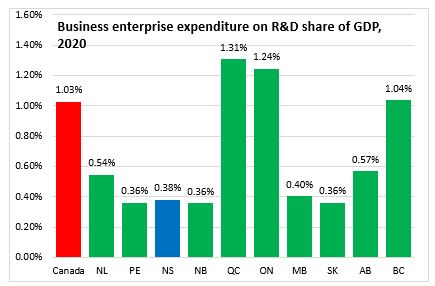
As a share of GDP, business R&D expenditures in Nova Scotia has been somewhat volatile over the last seven years. The share of industrial R&D in total GDP in Nova Scotia increased from 2014 (0.30%) to 2016 (0.44%) but were on a downward trend from 2016 to 2018 (0.35%) before increasing in 2019 (0.43%) and decline in 2020 (0.38%).
Nationally, the share of business R&D in GDP had been hovering around 0.92% from 2014-2019, before increasing as a share of GDP in 2020 to 1.03%.
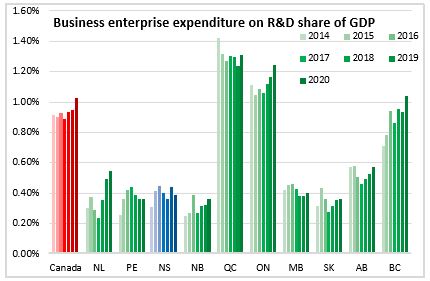
In 2020, R&D personnel accounted for 0.58% of Nova Scotia’s business sector employment, posting the second largest share across the Atlantic provinces.
Nationally, business enterprise R&D personnel was 1.35% of Canada’s total business sector employment in 2020. The largest shares were recorded in Quebec (1.74%), Ontario (1.60%) and British Columbia (1.35%).

Over the last seven years, the share business sector employment that has been business enterprise R&D personnel has generally been on a downward trend with spikes recorded in 2016, 2019 and 2020. The share of Nova Scotia’s R&D personnel peaked at 0.66% in 2016 before declining to 0.42% in 2018 and increasing to 0.58% in 2020.
In Canada, the share of R&D personnel in business sector employment was previously at its highest at 1.16% in 2015. This ratio declined to 1.02% in 2017 and was stable at 1.13% over 2018 and 2019. In 2020, the R&D personnel share increased to 1.35% as research personnel grew while business sector employment fell amid the COVID-19 pandemic.
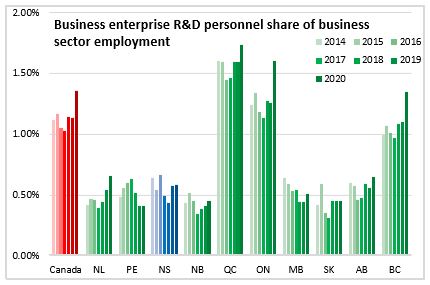
In 2020, there were 1,671 full-time equivalent (FTE) jobs for in-house research and development in Nova Scotia. This was a decrease of 7.9% from the previous year. Researchers and research managers (1,145) was the most dominant occupational category among most Nova Scotia’s business enterprise R&D personnel in 2020. The rest of the R&D personnel was divided among research and development technical, administrative and support staff (475), and consultants and contractors (51).
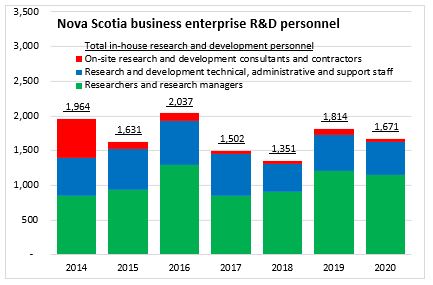
Preliminary estimates show that Canada’s business enterprise R&D spending grew by 3.5% from the previous year to $23,430 million in 2021. National R&D expenditures are expected to have slower growth of 1.7% to $23,823 million in 2022.
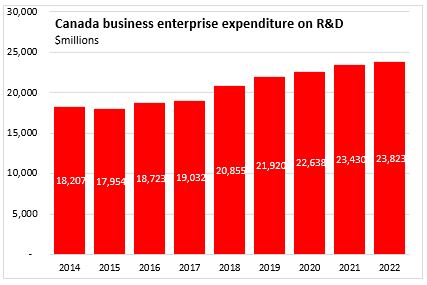
Looking at the R&D spending by industry, majority of the R&D spending in Canada was undertaken by businesses in service sectors. The computer systems designs and related services sector had the largest R&D spending ($4,164 million) in 2020. This was followed by research and development: sciences/engineering ($2,255 million) and wholesale sector ($2,133 million).
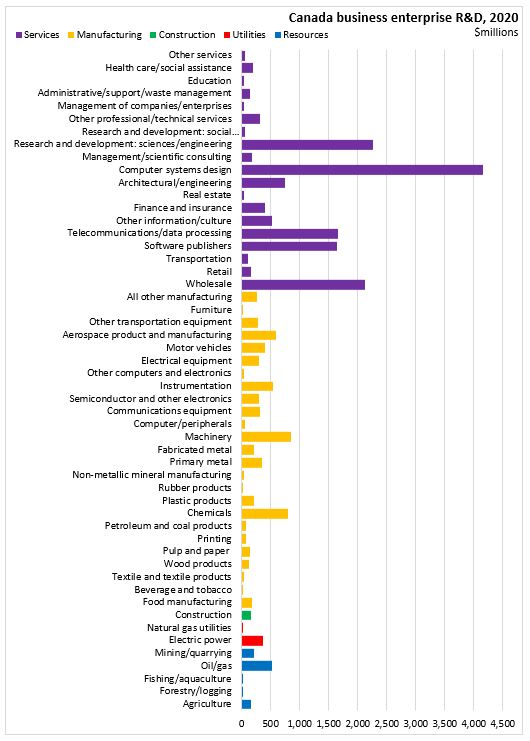
In 2020, Canadian businesses with revenues higher than $500 million had the largest share of total R&D spending accounting for 36% of total R&D expenditures. This was followed by businesses with revenues between $10 million and $50 million (18%) and revenues between $100 million and $500 million (16%) in 2020.
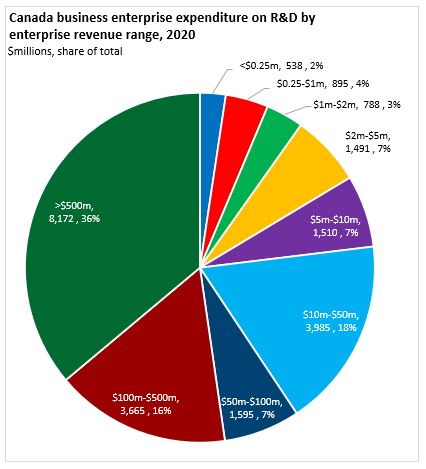
Source: Statistics Canada,Table 27-10-0333-01 Business enterprise in-house research and development expenditures, by industry group based on the North American Industry Classification System (NAICS), country of control and expenditure types (x 1,000,000); Table 27-10-0334-01 Business enterprise in-house research and development expenditures, by country of control and revenue group (x 1,000,000); Table 27-10-0341-01 Business enterprise in-house research and development characteristics, by industry group based on the North American Industry Classification System (NAICS), country of control and provinces and territories; Table 36-10-0222-01 Gross domestic product, expenditure-based, provincial and territorial, annual (x 1,000,000); Table 36-10-0480-01 Labour productivity and related measures by business sector industry and by non-commercial activity consistent with the industry accounts
<--- Return to Archive